What Is Data Strategy?
A data strategy is a comprehensive plan for handling an organization’s data. It outlines technology, processes, and rules to manage data effectively. It also provides clear guidelines for acquiring, storing, distributing, and using data.
Why is this necessary?
Because businesses of all sizes collect and produce huge amounts of raw data.
An estimated 181 zettabytes of data will be generated worldwide by 2025. To put that into perspective, one zettabyte is roughly the equivalent of streaming Netflix continuously for 36 million years.
That’s a lot of data.
Image Source: Statista
Managing all this data, keeping it secure and compliant, and using it to drive business value can be challenging.
After all, data is only useful if you can actually use it. Unfortunately, many businesses experience issues like silos and duplicates, and incomplete, inaccurate, or obsolete data. Or, even worse, a data breach.
Creating a data strategy addresses these issues (and more) so businesses can use their data in meaningful ways and gain a competitive advantage.
Further reading: What Is Data-Driven Marketing, and Why Is It Important?
What Are the Benefits of a Data Strategy?
A solid data strategy plan is essential for most businesses today. Let’s explore the key benefits:
Smarter Decision-Making
Analyzing trends and insights enables companies to understand what’s working, what’s not, and what could happen. This helps them make smarter, faster decisions.
To make more informed decisions, a company’s data strategy might include the following popular analytics model. It has three key elements: descriptive, diagnostic, and predictive analytics.
Descriptive Analytics
Descriptive analytics involves analyzing historical data to understand what has happened in the past.
For example, a company might use Excel or Google Sheets to review sales data and identify seasonal changes. Or they might look at competitor data, like the number of visitors and traffic sources, using Semrush’s Traffic Analytics.
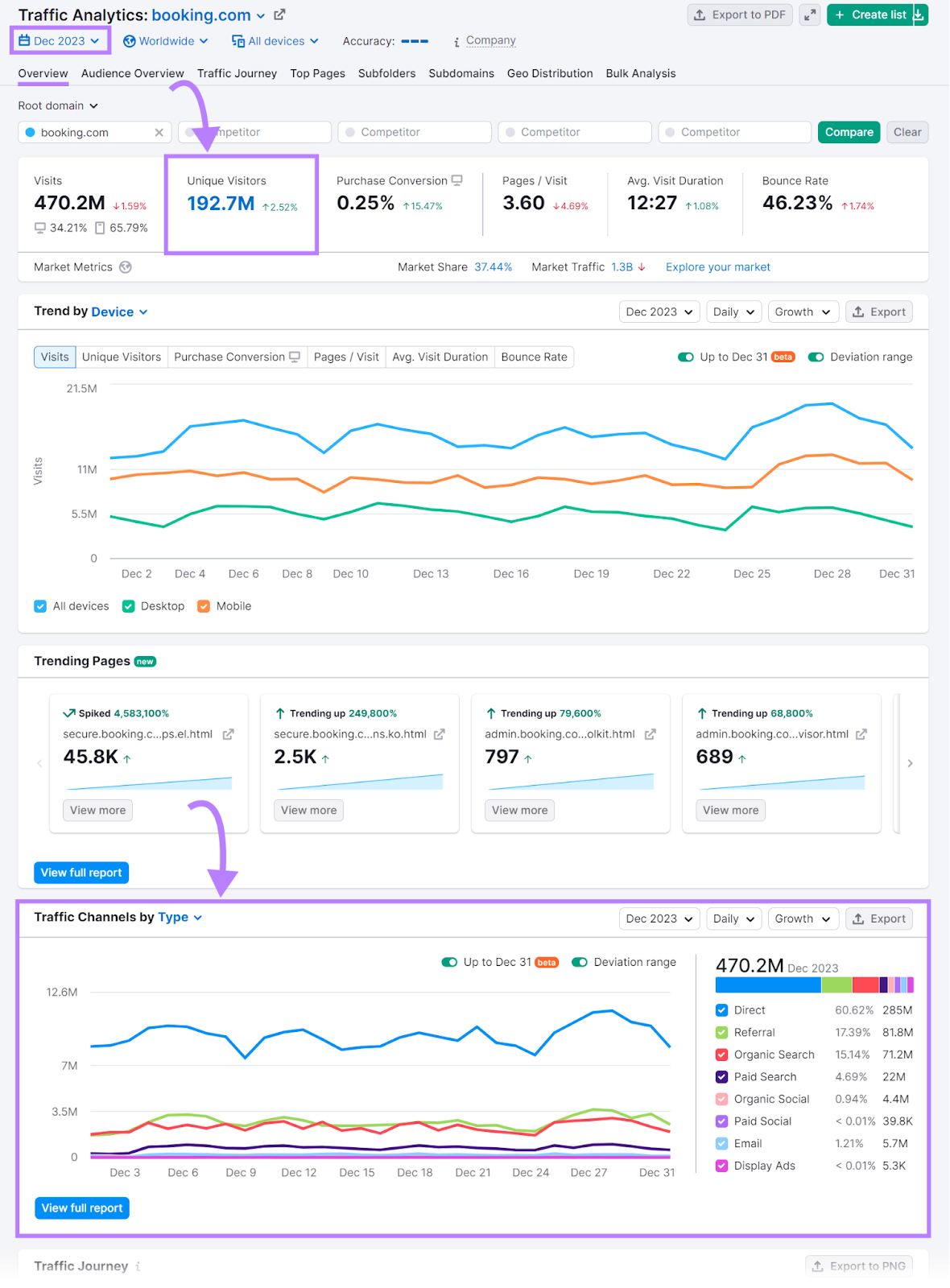
Further reading: What Is a Competitive Analysis and How Do You Conduct One?
Diagnostic Analytics
This type of analytics delves into the reasons behind past events.
Let’s say you notice some changes in your Google Ads performance and want to figure out why they’re happening.
Our Advertising Research tool can help you monitor your rivals’ pay-per-click (PPC) activities, including their ad spend and ad copy. You can use these insights to identify competitive trends and strategies that might influence your ad performance.
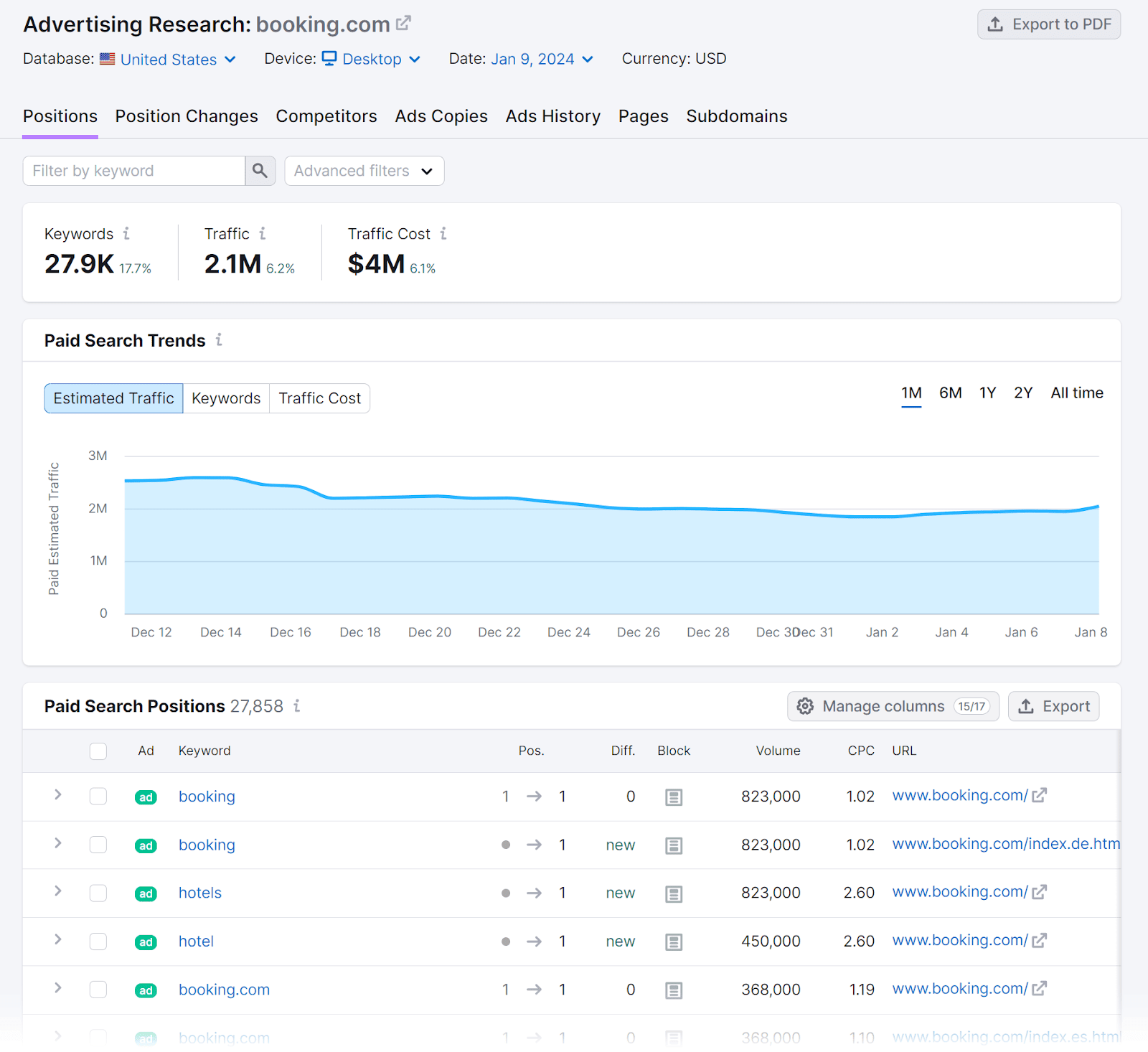
Predictive Analytics
Predictive analytics forecasts future events based on what has happened before.
This usually requires advanced statistical analysis and artificial intelligence (AI) or machine learning (ML) technology.
Historical insights and future predictions enable the company to anticipate new trends and tailor its product development and marketing efforts.
Better Customer Experience
Data helps businesses understand how, when, where and what their customers like to buy. And what makes them tick.
Brands can use customer data to:
- Personalize key touchpoints, like the website and customer service channels
- Optimize products and experiences
- Do a better job of meeting customer needs
For example, brands can email customers when their favorite product comes back in stock or they’re due for a refill. Like pet food brand Chewy does here:
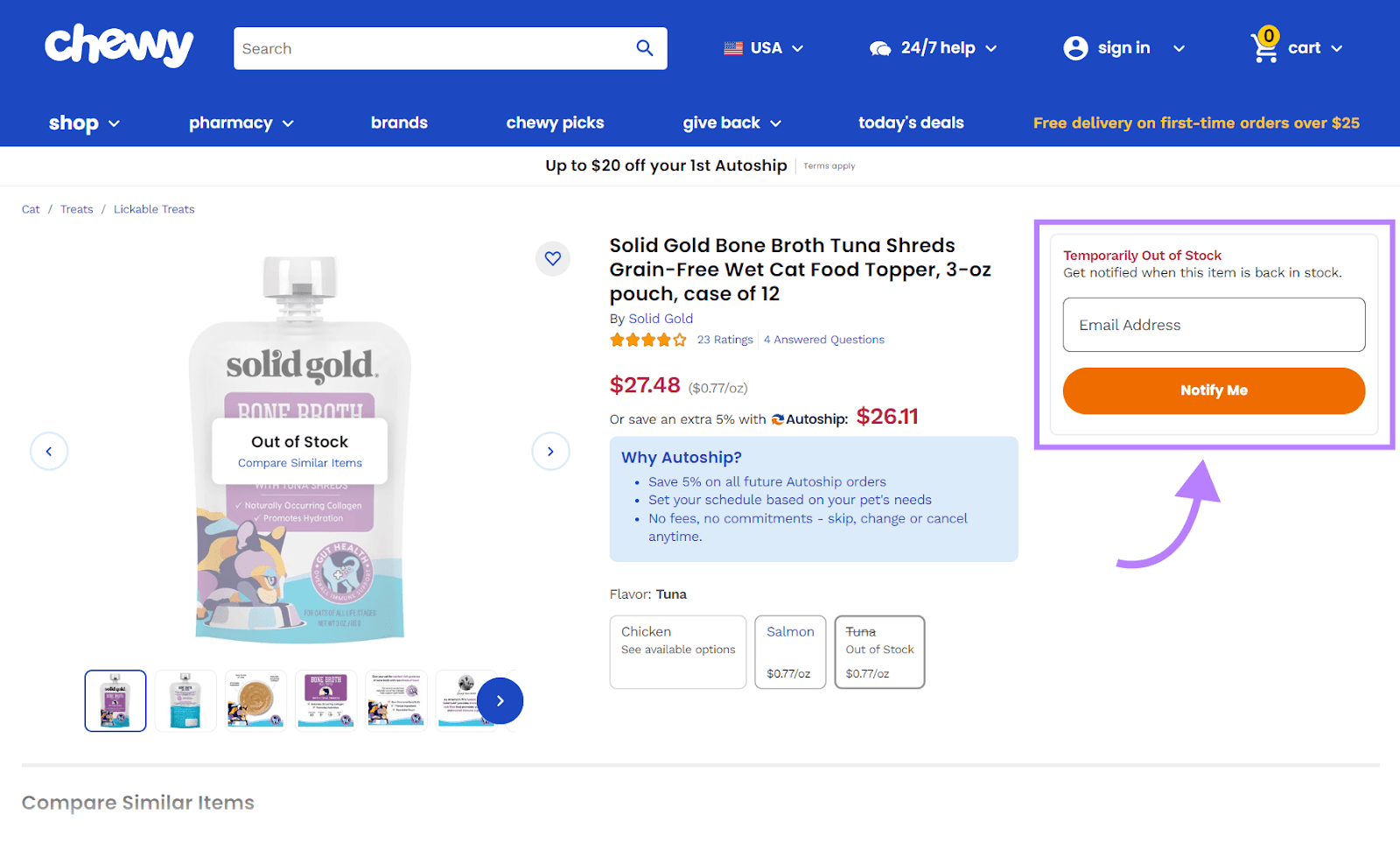
This helps boost customer loyalty and avoid missed sales.
Improved Data Compliance and Security
Brands handle large amounts of confidential customer data. Like names, addresses, and credit card information.
For example, let’s say you’re a regular shopper at Target and want to sign up for special deals and a birthday gift. They ask you for personal information, including your name, email address, and phone number.
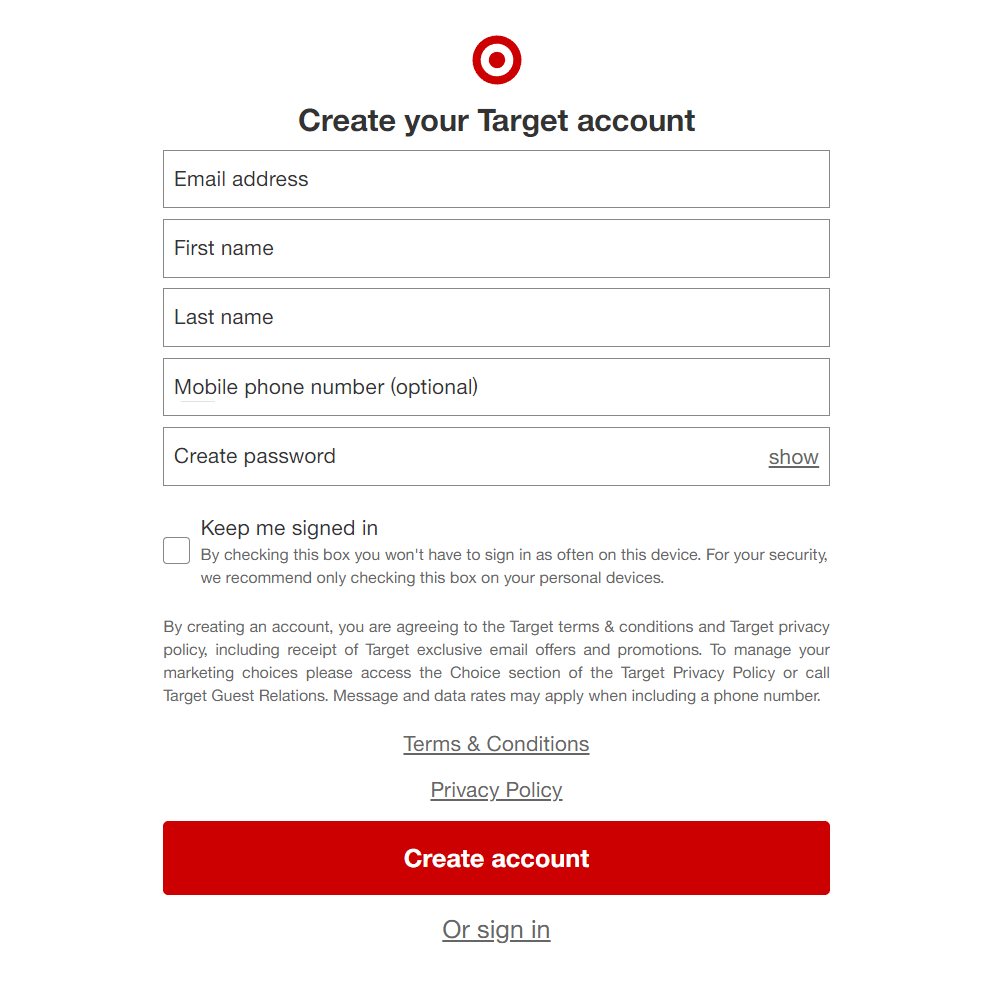
Brands have a responsibility to their customers to keep these details safe.
Dropping the ball on privacy and security can cost businesses a lot of time and money. According to IBM research, the global average cost of a data breach was $4.45 million.
Unfortunately, data hacks and cybersecurity incidents happen all the time. In fact, the same IBM research showed that 51% of organizations planned to improve security due to a breach.
A solid strategy helps businesses store and manage customer data securely so only authorized people can access it—for the intended purpose.
Increased Efficiency and Reduced Costs
Data can shine a spotlight on areas where businesses need to improve.
So they can:
- Optimize workflows
- Improve budgeting
- Adjust resource allocation
- Save costs
What’s more, a data strategy can help businesses spot opportunities, like new revenue streams and business ******. Which can further reduce costs and drive revenue.
Adoption of Advanced Technologies
Organizations that use security AI and automation save $1.76 million compared to those that don’t. But to leverage these solutions and gain the benefits, businesses need clean, accurate, accessible data.
Advanced technologies like AI and ML use significant amounts of data. A data strategy helps ensure data meets the required quality standards so businesses can adopt new technologies and data ****** with confidence.
Types of Data Strategy
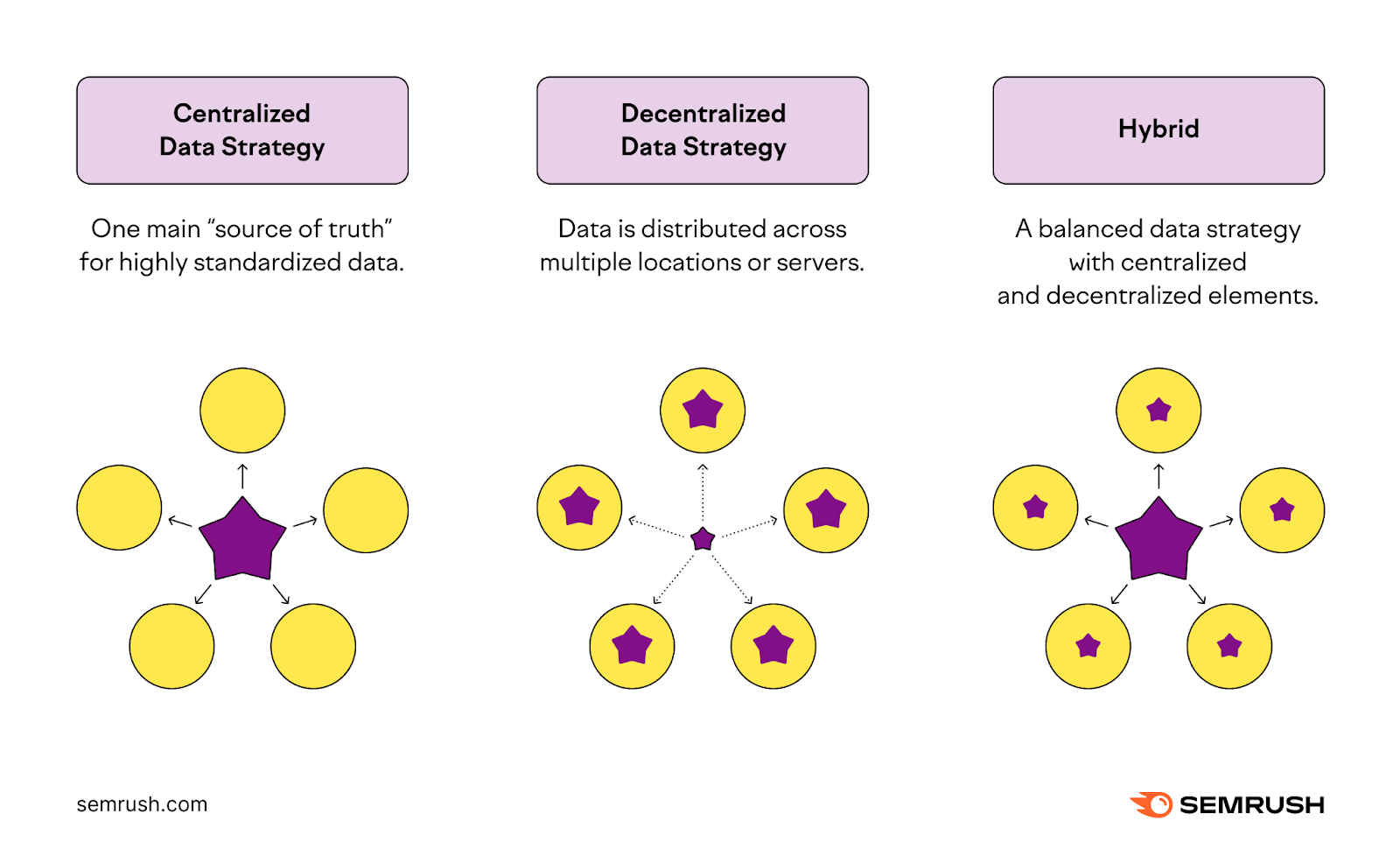
Organizations can adopt different data strategies based on their needs: centralized, decentralized, or hybrid.
Centralized Data Strategy
A centralized approach to data strategy involves one main “source of truth.” A single, central repository collects and stores data from multiple sources, like customer feedback and sales transaction records.
This approach ensures standardization and consistency of critical data like revenue, customer, and sales information.
This is especially beneficial for large organizations that must maintain uniformity across different departments.
Why?
So everyone works with the same, reliable data for performance assessment and decision-making.
Decentralized Data Strategy
A decentralized data strategy offers flexibility, with data distributed across multiple locations or servers. This approach suits organizations operating in a fast-changing environment or with independent departments with different data needs.
For instance, a startup with different project teams might prefer this for scalability and to avoid a single point of failure—meaning if one data source goes down, others remain functional, ensuring continuous data access.
Hybrid Data Strategy
A hybrid data strategy combines centralized and decentralized approaches.
For example, in a company using a hybrid approach, the finance and marketing departments might rely on centralized data for creating monthly performance reports. This is the centralized aspect. Meanwhile, the finance department might also incorporate specific financial data exclusive to them. This is decentralized.
A balanced approach lets companies maintain a single source of truth for overarching business metrics. At the same time, individual departments have the flexibility to use and manage data in ways most suited to their specific functions.
This strategy is ideal for medium to large companies requiring both company-wide consistency and department-specific agility in data handling.
Overall, the choice of data strategy depends on the company’s size, structure, industry, and needs.
Further reading: 6 Types of Reports for Making Data-Driven Decisions
Data Strategy Framework
Before building a data strategy, it’s important to understand what a data strategy consists of. Your data strategy framework should consider the following essential data strategy components:
Data Governance
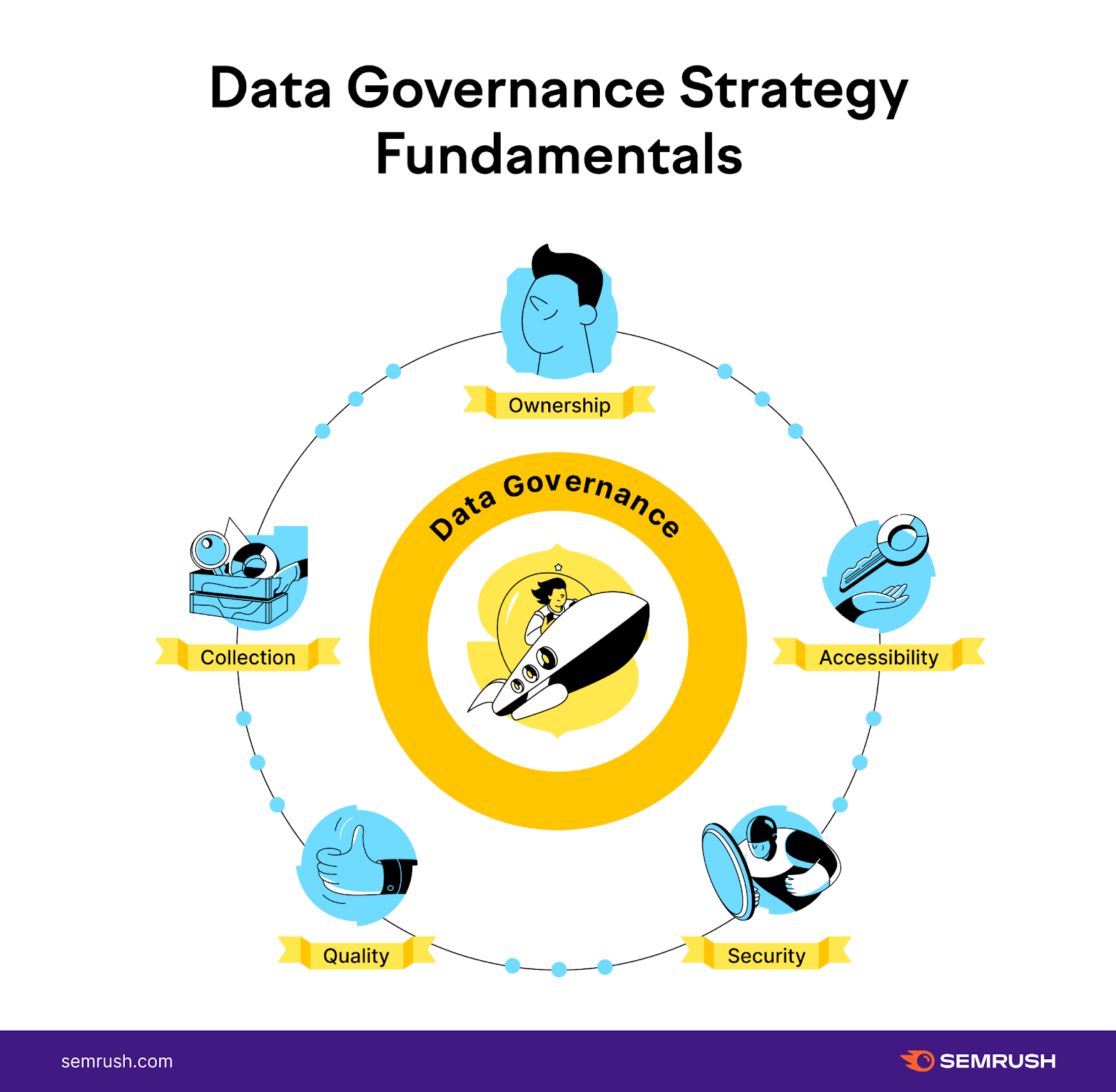
Data governance involves establishing rules, policies, and standards to ensure data across the organization is secure, accurate, and compliant. It determines what kind of data is collected and how. And it clarifies data ownership and who has access to what.
Data Quality
Data quality evaluates a company’s data based on factors like:
- Accuracy
- Completeness
- Consistency
- Reliability
- Freshness
Assessing data quality helps organizations spot any errors or issues and determine whether the data in their systems is fit to serve its intended purpose.
Data quality is important. According to Gartner, poor data quality costs organizations $12.9 million per year on average.
To determine the quality of their data, organizations can inventory their data assets and perform baseline studies to measure the accuracy, uniqueness and validity of selected data sets. Data management tools can help with this.
Data Architecture
Data architecture refers to the overall structure and setup of an organization’s data ecosystem. This includes the design of databases and any other tools used to store or manage data. Like data warehouses (central repositories of information) and cloud platforms (online data storage solutions).
Data architecture aims to ensure that the data infrastructure supports the organization’s requirements in terms of performance, scalability, and reliability.
For instance, consider a fast-growing startup. As the business scales, its data needs will also evolve. Initially, a small database might be sufficient. However, as the company grows, this basic setup probably won’t be able to handle the increased volume and complexity of data.
Data Compliance
Data compliance ensures an organization’s handling of data is in line with relevant data protection laws and regulations.
Almost every business collects at least some data on its customers. Even if it’s just website cookies and email addresses, like this:
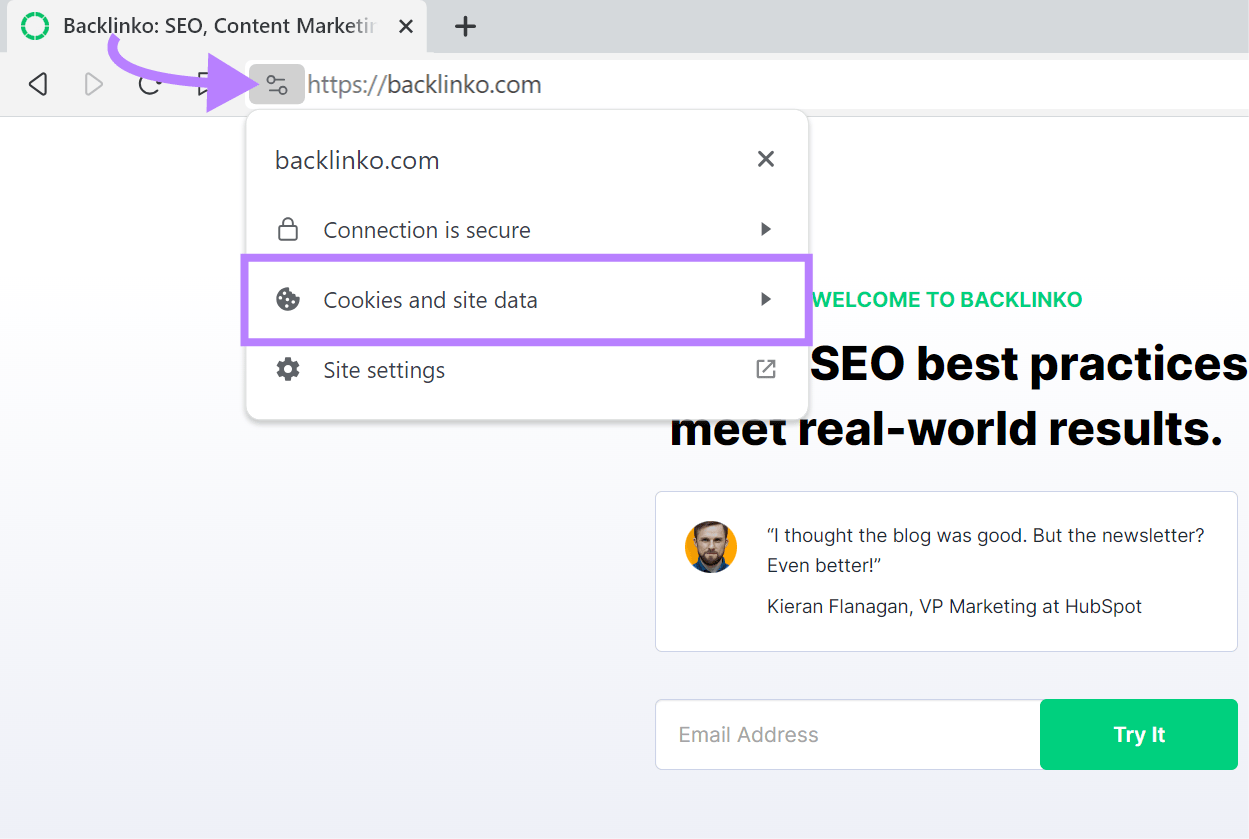
Companies are legally obligated to keep customer data safe and use it fairly, which is where privacy laws come in.
Privacy laws set clear expectations for how companies should handle people’s personal information. They tell businesses what they can and can’t do with the data they collect—like not sharing it with third parties without permission. Failure to comply can lead to heavy fines.
The laws you need to follow will depend on where your company is based and where you do business.
For example, if you operate within the European Union or handle data from EU citizens, you likely must comply with the GDPR (General Data Protection Regulation). Similarly, if your business activities involve the state of California in the U.S., the CCPA (California Consumer Privacy Act) likely applies.
Data Security
Data security is the practice of protecting data from unauthorized access. Like ransomware hacks and other cybersecurity threats.
Data security includes elements like:
- Encryption: Converting data into a coded format to prevent unauthorized access
- Access control: Setting user permissions to restrict data access to authorized individuals only
- Regular audits: Conducting checks to identify vulnerabilities and update security measures
- Employee training: Educating staff on how to avoid common cyber threats, like phishing emails
- Incident response planning: Preparing a clear plan on what to do in the event of a data breach
Data Operations
Data operations cover the day-to-day management of data. This includes data processing, backup, recovery, and maintenance.
Efficient data operations ensure that data is always available and reliable, supporting ongoing business activities and decision-making processes.
Analytics and Reporting
Analytics and reporting transform raw data into meaningful insights. This involves data analytics platforms to analyze data and generate reports to inform business strategies.
Analytics is important because it enables organizations to turn their data into insights. So they can identify trends, patterns, and opportunities. Such as which products are the most popular, which marketing channels are most effective, and which markets they should focus on or expand into.
Data Culture and Literacy
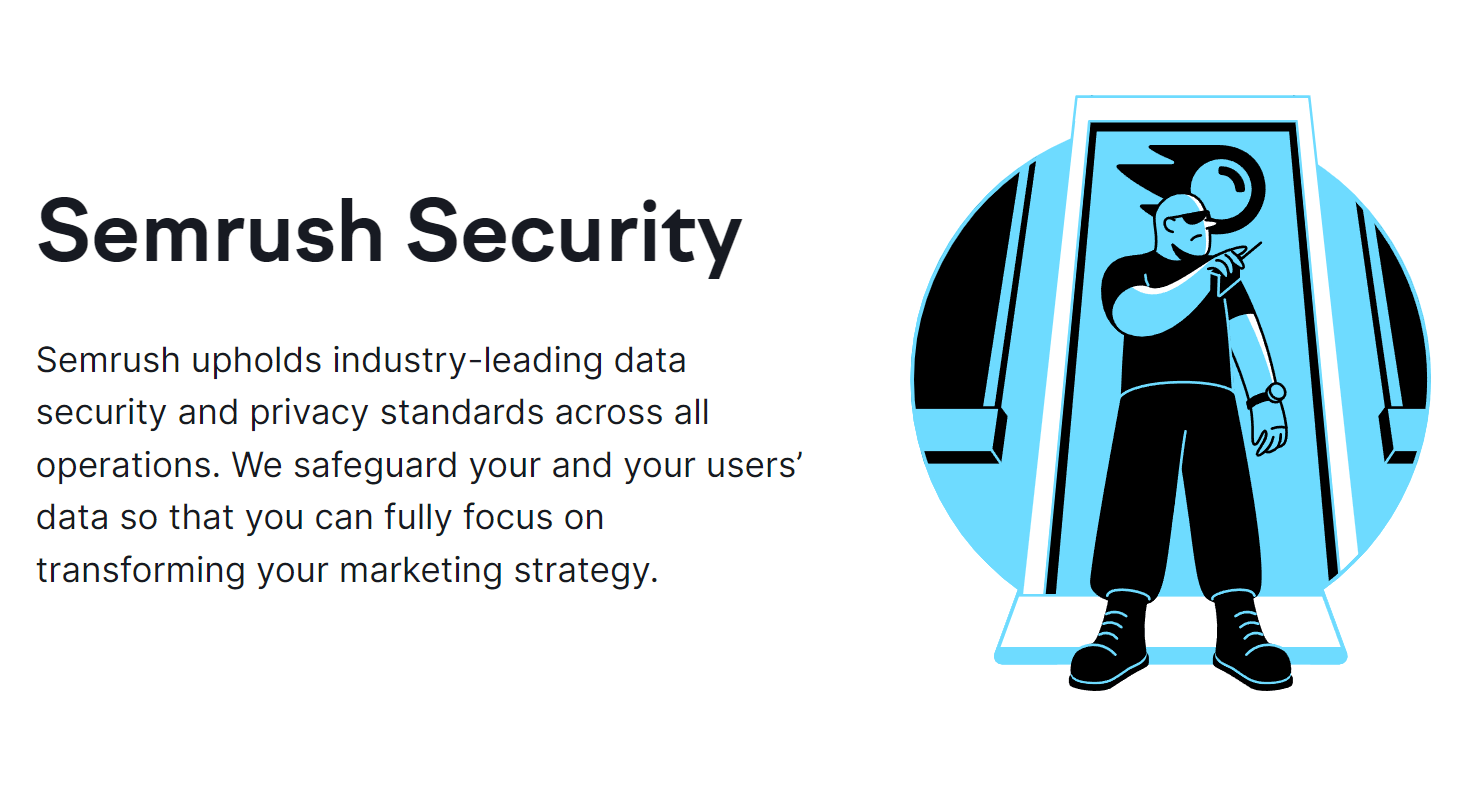
Typically, a company collects data on two groups of people: employees and customers. Both groups should know what kind of data the company collects, why, and how it is stored and processed.
Customers need to be sure you are handling their data in a secure and compliant way. And that information needs to be transparent. For example, Semrush’s data security policy is visible on the company website.
Educating and engaging employees is key to leveraging data effectively. A data-driven culture encourages a mindset where employees use data to guide their decisions, leading to improved business performance.
How to Build a Data Strategy in 7 Steps
Now you understand which components of a data strategy are important, you’re ready to create your data strategy. The following data strategy best practices will help you do just that.
1. Align with Key Stakeholders
Key stakeholders, like IT and business leaders, are critical in providing the necessary insights and buy-in to support a data strategy. Their involvement helps ensure the strategy aligns with business needs and expectations.
To understand their priorities and pain points, you can ask them questions like:
- What are your main business goals and initiatives that require data and AI?
- What are your biggest challenges when it comes to achieving those priorities?
- What do you wish you could use data for that you can’t right now?
2. Define Clear Objectives and Use Cases
Clear objectives and concrete use cases provide direction and purpose to the data strategy.
Objectives should be closely aligned with overall business goals. Such as increasing market share, improving customer satisfaction, and driving operational efficiency.
Then, you can drill down into key uses to understand how different departments and teams use data, what types of data are most valuable to them, and the outcomes they would like to achieve.
Potential use cases could include:
- Increase customer loyalty through personalized marketing strategies
- Optimize inventory and supply chain management
- Drive product innovation by analyzing customer feedback
- Improve financial performance through cost reduction
- Improve customer service by analyzing customer interactions
3. Conduct a Data Audit
Evaluate your existing data infrastructure, tools, and processes. This thorough audit should identify how you currently collect, store, process, and use data in your organization.
Here’s how you can do that:
- Data inventory: Begin by cataloging all data sources within your organization. Tools like Apache Atlas and Alation can assist in mapping and understanding your data landscape.
- Data quality assessment: Use data quality tools such as Informatica or Talend to assess your data’s accuracy, consistency, and completeness. This step is vital for identifying data quality issues that could impact analytics.
- Infrastructure evaluation: Review your data storage, processing, and management systems. Tools like AWS Well-Architected Tool and Microsoft Azure’s Advisor can offer insights into the efficiency and security of your cloud infrastructure.
- Process analysis: Examine your data collection, storage, and utilization processes.Process mining tools like Celonis and Signavio can identify inefficiencies or bottlenecks in your data workflows.
4. Develop Data Governance Policies
Now, it’s time to create data governance policies to define data ownership, roles, responsibilities, and procedures.
Start by consulting with the key stakeholders defined in step one. This collaborative approach ensures that your policies are aligned with various business objectives.
Here are some key policies you are likely to need:
- Data ownership: Defines who owns various data assets within the organization
- Data quality: Establishes standards for accuracy, completeness, and reliability of data
- Data access and control: Outlines who can access data, under what conditions, and with what level of authority
- Data privacy and protection: Includes guidelines for protecting sensitive data and complying with privacy laws
- Data retention Determines how long data is kept and how it is archived or disposed of
- Data usage: Sets rules for the appropriate use of data within the organization, including how and when it can be shared
5. Develop an Implementation Plan
With your data governance policies defined, the next step is to turn these policies into action. That’s where a comprehensive implementation plan comes in. It serves as a roadmap to help you execute your data strategy.
Here’s what you’ll need to do:
- Write down and share the policies: Most businesses have internal policies (for employees) and external policies (for the general public). Consider how, when, and where to publish and distribute this information. For example, you may need to add a privacy policy to your website.
- Identify required changes: Based on the data audit, figure outwhat changes are necessary to align with the new policies. This could include upgrading technology, modifying data processes, or introducing new data management practices.
- Allocate resources: Determine the resources needed for implementation, including personnel, technology, and budget. Ensure that these resources are allocated appropriately to support the execution of the plan.
6. Educate Employees
For a data strategy to succeed, all employees must understand its importance and be aware of changes. Effective education and communication are essential.
Here’s how to educate employees:
- Assess training needs: Figure out how different departments and roles use data and what they need to know
- Create a training program: A structured training program should include data strategy essentials, like governance, policies, and the impact on employees’ daily tasks
- Leverage internal platforms: If your company is using Slack, for example, you can create a data governance channel where employees can ask questions, share insights, and access key resources
This helps employees get up to speed with the data strategy and all relevant policies.
7. Continuously Monitor and Refine Your Data Strategy
Finally, regularly monitoring and adjusting your data strategy is essential for its long-term success. You should:
- Compare the outcomes and your business objectives
- Make necessary adjustments to stay aligned with evolving business needs and market conditions
- Ask users for feedback via Google Forms, Slack channels, or other survey tools
You’ll need the right tools to ensure your data is insightful, secure, and compliant.
Let’s explore the key types of data strategy tools, from data management systems to analytics platforms and security solutions.
Data Management Tools
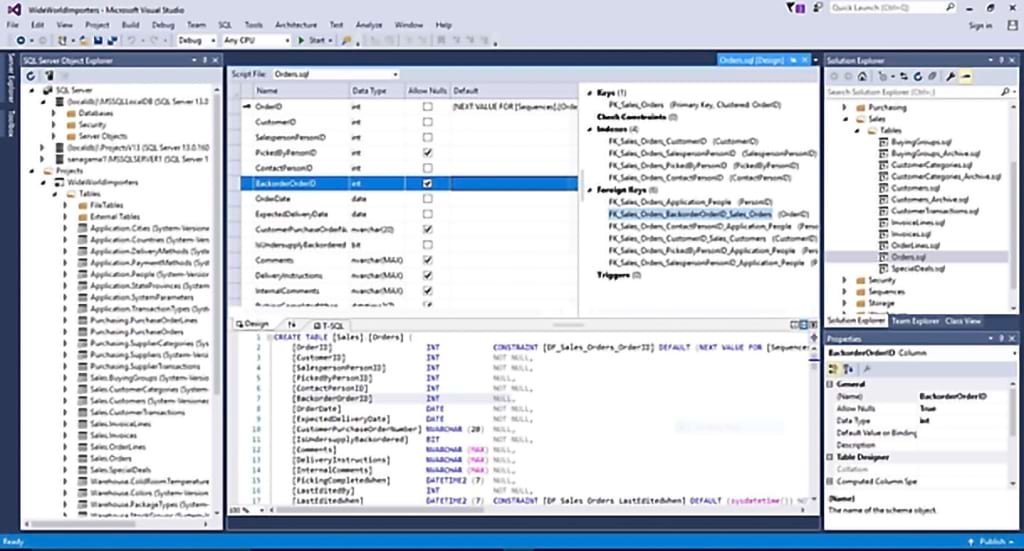
Image Source: Microsoft
Data management tools are the backbone of any data strategy. They store, process, and manage large amounts of data.
This includes databases like Oracle, a comprehensive and widely used database system known for robust performance and scalability. And Microsoft SQL Server, which offers a combination of advanced analytics and security.
Data management also includes cloud-based solutions. Meaning businesses can store and access them over the internet. Popular solutions include AWS, Microsoft, and Panoply.
Data Analytics and Visualization Tools
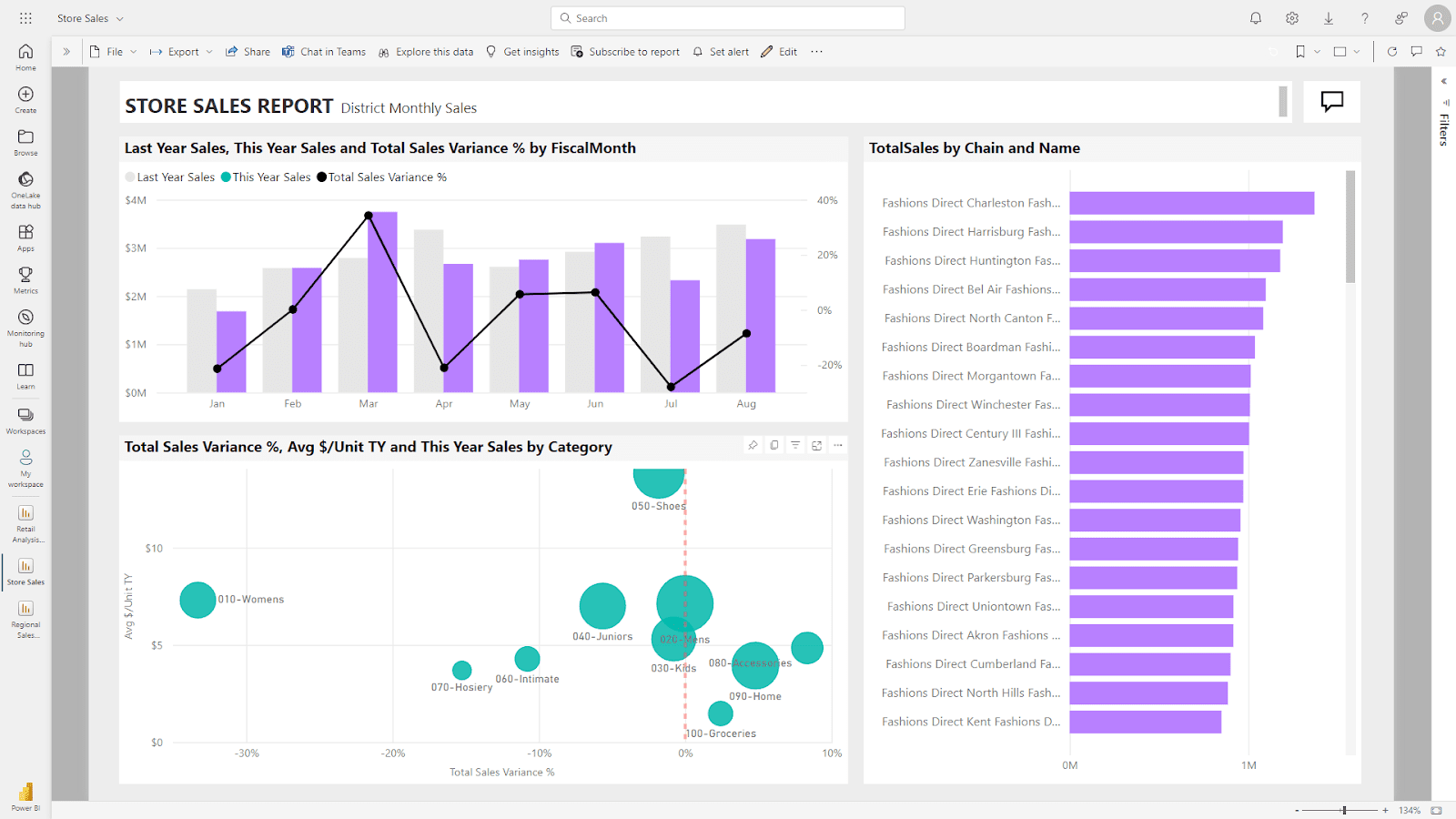
Data analytics platforms help organizations slice and dice raw data and turn numbers into trends and actionable insights. Like which products people buy the most, or which times of the year are most profitable.
Analytics platforms offer a range of functions that allow businesses to perform complex statistical analyses.
Data analytics platforms encompass general business analytics tools.
For example:
- SAP Analytics Cloud is a platform that combines business planning with dashboards, reporting, and predictive analytics
- Microsoft Power BI lets you consolidate data from different sources and create reports, dashboards, and data visualizations
Marketing Analytics Tools
Market analytics tools play a key role in your data strategy. They can help you understand marketing performance, competitors, and, most importantly, your customers.
For example, Market Explorer enables you to analyze any market, identify industry leaders and their acquisition channels, see traffic trends, and check audience demographics.
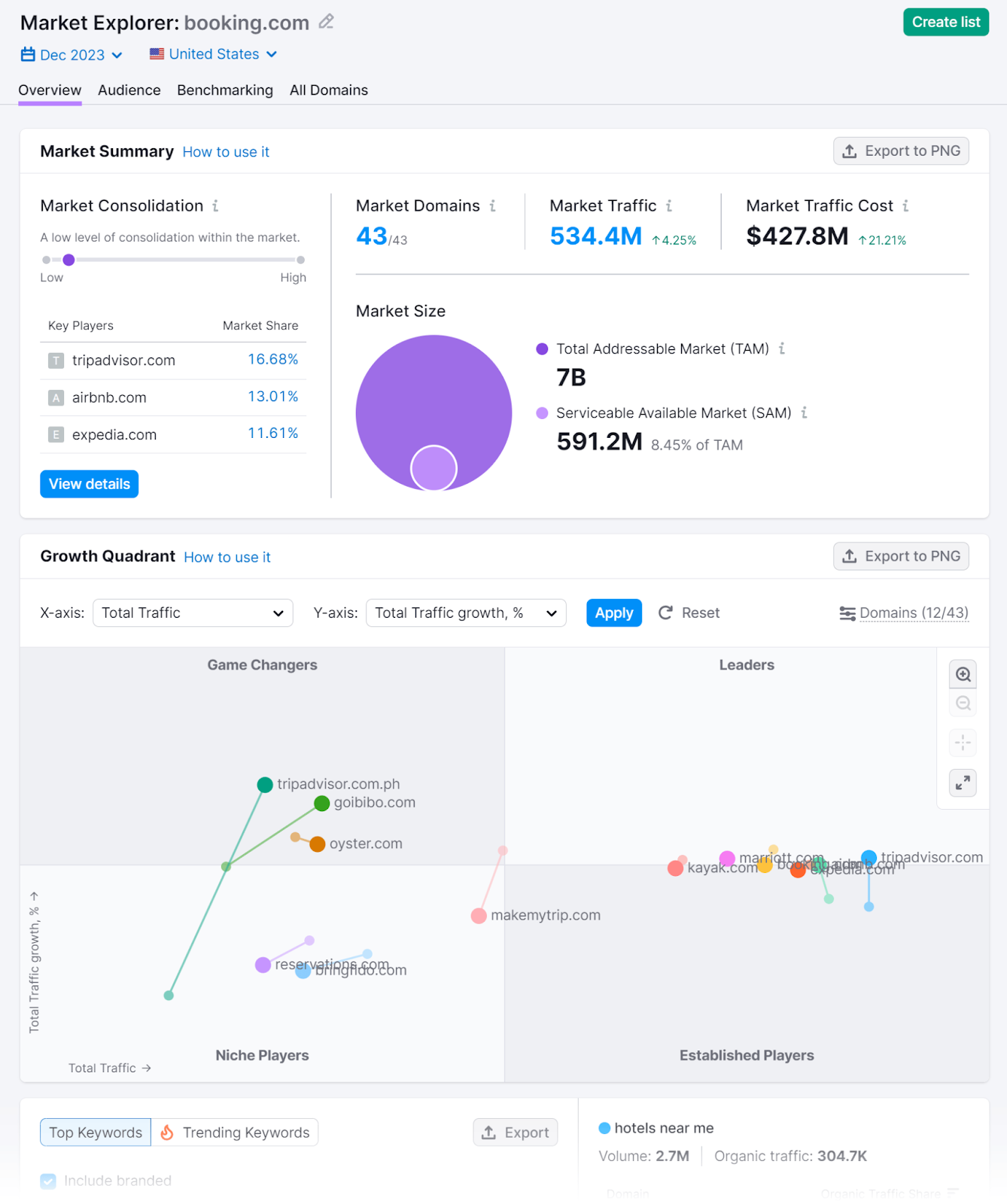
And a tool like Traffic Analytics will provide data on competitors’ website traffic, including the number of visitors and where they came from.
Google Analytics tracks and reports website traffic, providing insights into user behavior and website performance.
Data Security Solutions
Security solutions protect organizations’ data from unauthorized access, breaches, and other threats.
They include features like encryption, intrusion detection systems, firewalls, and access control mechanisms, providing a shield against hackers and cybercriminals.
Common cybersecurity solutions include Acronis for data backup, disaster recovery, and secure file sharing and Cohesity for data management to defend companies against ransomware and more.
Successful Data Strategy Examples
Let’s explore how some leading companies have successfully implemented data strategies to understand their customers and meet their needs better.
Netflix

Netflix uses data to offer highly personalized viewing experiences and decide which shows to invest in.
The streaming platform greets users by name when they open the platform and provides personalized recommendations on the home screen. Netflix says these recommendations are based on a user’s viewing habits and the behavior of similar users.
Netflix doesn’t just recommend shows users are likely to enjoy. Netflix also personalizes many aspects of the platform, including:
- Title cards and imagery
- Messaging
- Trailers
For example, Netflix created 10 versions of the “House of Cards” trailer to promote the show. Users who liked a specific actor in the show were more likely to see a trailer with them in it, personalizing their viewing experience.
This tailored approach enables Netflix to show audiences the most appropriate shows for them in the most appealing way.
Starbucks
Starbucks’ rewards program collects data to enhance customer experiences and drive loyalty.
Customers can sign up for free and start collecting member points (known as stars) using the Starbucks mobile app. This not only encourages customers to consume more Starbucks products to collect points, but it also gives the company a ton of data.
Starbucks can use that data to:
- Send tailored offers via email and in-app push notifications
- Monitor which locations are popular (and which aren’t)
- Engage with customers on their birthdays
- Reach out to customers who haven’t ordered in a while
This all helps Starbucks foster brand loyalty and boost recurring sales.
Airbnb

Airbnb is a leader in the hospitality industry. And it’s a great data strategy example. They use data to increase the likelihood of guests finding a place they’ll enjoy.
When a guest searches for accommodation, Airbnb uses machine learning algorithms to match guests with relevant listings. The search results page is essentially personalized recommendations based on the places guests click on, the places they view, and host preferences.
This data-driven approach helps guests find somewhere they are likely to book. Which helps Airbnb drive more bookings and happy customers.
Create Your Own Powerful Data Strategy
Data is more than just numbers and statistics. It’s a valuable asset that can open doors to new opportunities, innovations, and growth.
In the era of big data and AI, the businesses that succeed will be those that not only collect data but truly understand how to use it.
As you embark on your data strategy journey, remember that clear objectives and the right tools are essential.
Try Market Explorer now and start collecting customer insights to power your data strategy.
Source link : Semrush.com
